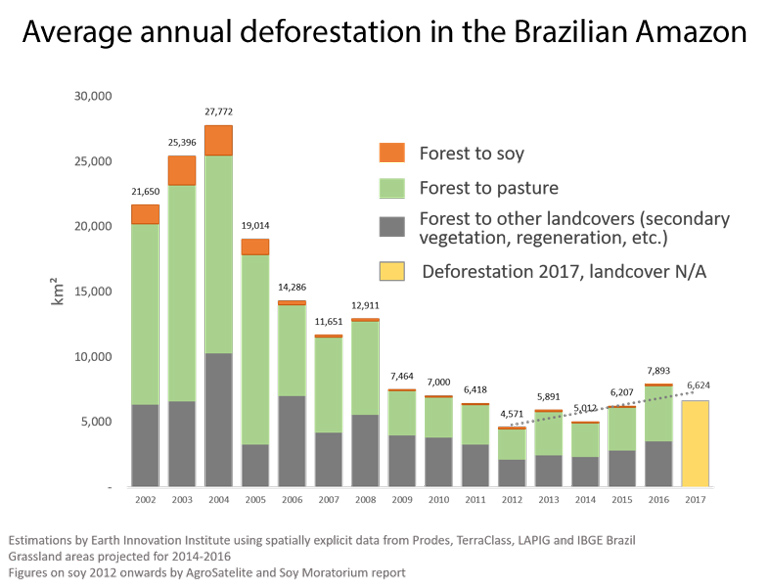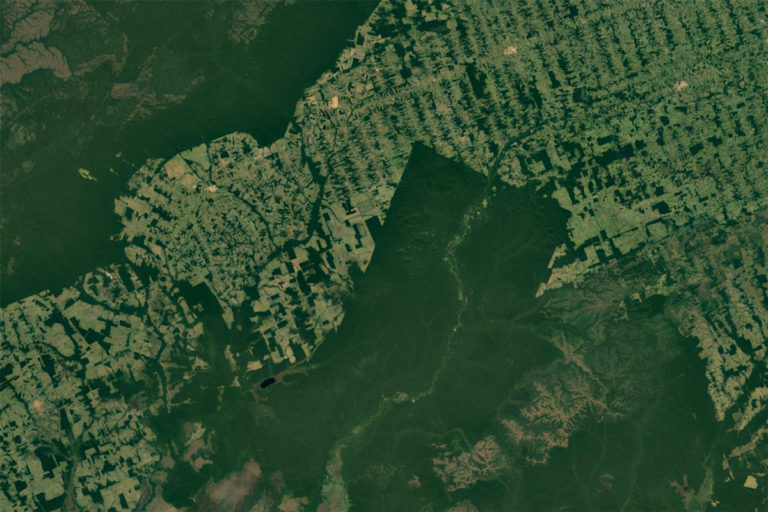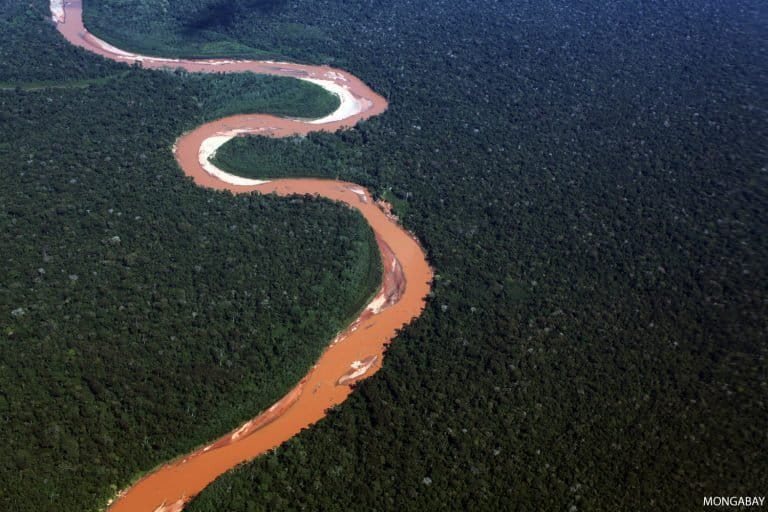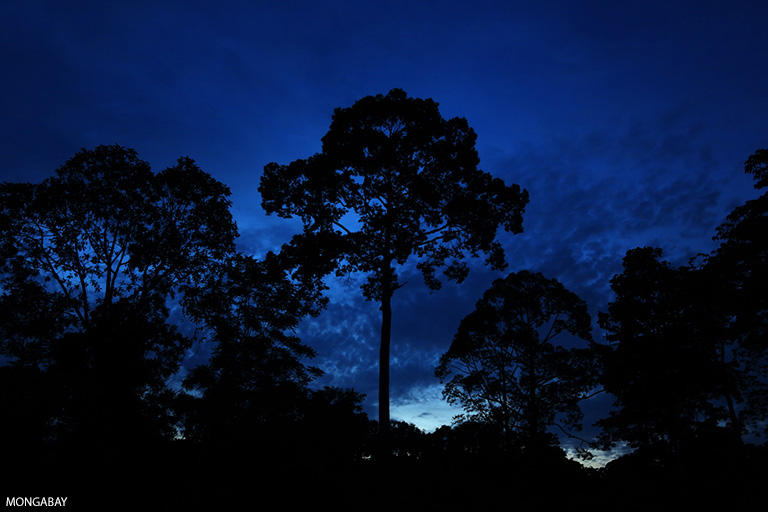- Ecologist Dan Nepstad is the founder and executive director of the Earth Innovation Institute.
- In this commentary, Nepstad makes the case for building stronger government support to end deforestation in tropical countries.
- Without this support, it may not be possible to further curb tropical deforestation.
- This post is a commentary. The views expressed are those of the author, not necessarily Mongabay.
We are in the midst of the greatest global effort in history to end tropical deforestation, driven largely by the importance of tropical forests for tackling climate change. An exciting new dimension of this effort is the announcement by hundreds of businesses that they intend to shift to “zero deforestation” sourcing of the commodities they import from the tropics.
Unfortunately, progress has not been as rapid as many had hoped; the chances of avoiding catastrophic climate change are smaller as a result.


In one respect, we are winning battles but losing the war. In the two mega-deforestation countries, Indonesia and Brazil, the forest loss associated with the expansion of palm oil and soybean production has declined. Regional rates of forest loss are flat or climbing (Figure 1), however. Deforestation in the Brazilian Amazon region in 2017 was 64% lower than its average from 1996 to 2005, but reached its lowest level in 2012 and has climbed steadily since then. In Indonesia, there is not yet a downward trend in national deforestation or deforestation in Kalimantan.
Strategy adjustments are urgently needed, as we concluded previously. The goal of ending and reversing tropical deforestation must be woven into a broader agenda and narrative that can win votes for bold political leaders who are proponents of sustainable development in their tropical forest regions. It must also recognize and reward the farmers, communities and businesses that are making the transition to sustainable production systems on the ground. Finally, it must address the anti-environmental backlash of farm sectors in tropical forest nations, most notably the Frente Parlamentar da Agropecuaria (aka, Bancada Ruralista), the most powerful political block in the Brazilian parliament. These three changes are interdependent, of course. This essay focuses on the missing case for governmental action. A subsequent essay will discuss winning over farmers.
We begin with a caveat: the number of political leaders who are committed to moving their tropical forest jurisdictions towards sustainable, green development is still quite small and their strategies are still quite fragile. One of the assumptions of this essay is that if these committed political leaders succeed, others will follow in their footsteps.
What strategies for slowing deforestation have worked?
The world’s biggest success story in reducing deforestation is the Brazilian Amazon, where deforestation has been 60 to 80% below its historical average beginning in 2009 (Figure 1). The decline is not because the Amazon is running out of forest. Eighty percent of the forest is still standing. The Brazilian government developed a jurisdictional performance system to achieve this reduction. It set deforestation reduction targets—80% by 2020—for the entire Brazilian Amazon region. It developed incentives for achieving those targets. And it monitored, reported and verified progress towards those targets with a reliable, transparent system. The strategy is far from perfect. It has been heavy on sticks and light on carrots, which is one reason deforestation is rising (Figure 1). Voluntary supply chain interventions, such as the Brazilian Soy Moratorium, contributed to the programs and policies implemented by the Brazilian national and state governments, but were not the main reason deforestation declined.
Brazil’s success demonstrates that governments control the biggest levers for influencing the decision that is made every year by millions of people who live in or work in tropical forests–to cut trees or not. Regulations, protected areas, and land-use zoning can—and in many places do—influence this decision. Public finance for farming and forestry can determine the types of activities that are financially viable. Fiscal incentives, including tax and trade policies, can favor one land use over another. The location and quality of transportation and energy infrastructure are often influenced by government, if not controlled outright. Governments are also usually the sole stewards of the power of law enforcement and military action.
All of these powerful levers can be used to favor either “tear-the-forest-down” or “sustainable” development models. And that is the nub of the tropical deforestation challenge. How will more political leaders and governments in tropical forest regions choose the pathway of sustainability?
The answer is deceptively simple: by framing the tropical deforestation challenge in a way that can win the support of most voters.

The political success of government leaders in democratic political systems is determined by voters and special interests. Around the world, citizens generally cast their votes for the political candidates and political parties who they believe will best represent and defend their interests. This is no different in tropical forest regions.
One of our key challenges today is that most voters in tropical forest regions believe that they will be better off with more deforestation, not less. The overwhelming scientific evidence that tropical forests are crucial to the stability of global and regional climate, flood control, water filtration, soil conservation, pollination and numerous other environmental services that improve the lives of tropical forest region residents, is less convincing and “real” than the simple metric that anyone who owns or seeks to own land knows very well: forest land is worth less than cleared land.
Let’s take the example of carbon dioxide, the most important greenhouse gas. The value of tropical forest carbon alone is huge but still not monetized, and as a result standing tropical forests do not compete well with the more immediate economic benefits of forest conversion to agriculture and livestock production. The ~300 tons of carbon (1,100 tons of CO2eq) stored in the wood of a single hectare of Amazon forest are worth $33,000 in avoided damages to the global economy caused by climate change. In contrast, a hectare of Amazon pasture that supports a single cow fetches $500 or so; a hectare of forest is worth much less.
And farming and livestock are only one of the economic interests seeking to open up tropical forest regions to development. Whether the resource being grabbed is land, timber, minerals, or hydrocarbons, the lobby that advertises “deforestation = development” is large and powerful, and very active during elections in pushing governments to cater to their interests.
So if sustainable development—and the tropical forest agenda—must compete with the propaganda pumped into voters’ homes by the “tear-it-down” lobbies, and the direct influence of these lobbies on political leaders, is there any hope?
Yes.

Building a case for governmental action: four steps
Here are four ways to build the governmental case for ending tropical deforestation. All of these changes are underway, part of an emerging new paradigm in tropical forest conservation and sustainable, inclusive development called “jurisdictional sustainability”, described in a recent “primer for practitioners”.
1. To the international community: find a narrative for strategies to end tropical deforestation that can win votes in tropical forest regions.
The battle cry for one faction can be a wet blanket for another.
“Zero deforestation” has become an international battle cry for addressing tropical deforestation. We were early contributors to this cry with our article entitled “The end of deforestation in the Amazon”.
Since then, we have learned how the phrase “zero deforestation” can alienate crucial allies. To achieve “zero deforestation” we may actually need a different way of talking about it.
To conservation-minded Brazilian farmers who have kept more forest on their farms than the law requires, “zero deforestation” means that their farms are worth less money than those of their neighbors who cleared more than they were allowed to by law, usually without any negative consequences.
To families and communities in tropical forest regions around the world who depend upon slash-burn-fallow agriculture to survive, the words “zero deforestation” can mean exclusion from markets, economic marginalization and a higher risk of running out of food.
To governments and political leaders of tropical forest regions, support for “zero deforestation” can be seen by their constituents as caving in to international pressure to forego the prosperity that flows from “opening the land”—prosperity that most industrialized nations enjoy in their own national territories.
The most powerful narrative for winning votes in tropical forest regions for political leaders who are determined to slow, end and eventually reverse deforestation is quite simple at one level: “We will have more jobs, more opportunities for education and economic prosperity, better health services, greater social justice, cleaner air, and cleaner water through new green economies that heal the land, its forests, its fisheries.”
This narrative is not a pipe dream. It’s being used today. To cite one example, in 1998, Governor Jorge Viana launched the concept of “Florestania (Forest Citizenship)” in the State of Acre in the Brazilian Amazon that was molded and further advanced by two subsequent administrations, including Jorge’s brother Tião, the current Governor. A majority of Acre’s voters believe they are better off with this green development pathway than with the alternative, although October 2018 elections will bring a new test. Acre citizens and businesses are now connected to Peru through the newly-paved Interoceanic highway, they take pride that their state is about to end illiteracy, health care is improving, GDP is rising, school kids are scoring higher on education tests, and forest communities have higher incomes. The State’s success in slowing deforesting is woven into this larger vision of green development.
And key sectors of the giant agricultural state of Mato Grosso in the Brazilian Amazon discovered that a shared definition of state-wide success in tackling deforestation, growing more food and supporting smallholder farmers can be achieved in just a few months. The lack of a shared definition of success is a surprisingly important barrier to progress on the ground. If Mato Grosso’s goals are reached, the“Produce, Conserve, Include Strategy” (PCI), which is just beginning to attract investment, would achieve zero net deforestation by 2030, keeping 6 billion tons of carbon dioxide out of the atmosphere. The political viability of Governor Pedro Taques’ gamble on the PCI will also be on display during the October elections.
In Peru, the “Public-Private Coalition for Low-Emission Rural Development” was launched in the department of San Martín last August with more than 45 organizations—businesses, farmer federations, regional governments and non-governmental organizations. This coalition is committed to solving tropical deforestation while increasing agricultural production and recognizing the rights of forest communities.

2. To businesses committed to sustainability: go beyond unilateral “zero deforestation” pledges to develop partnerships with regional authorities and farm sectors
The flurry of corporate “zero deforestation” pledges and implementation plans is an enormous opportunity to foster large-scale declines in tropical deforestation, but also one that brings considerable risks, as we reviewed in a 2016 publication entitled “Making corporate deforestation pledges work” and has been recently reported. To translate these pledges into positive impacts for tropical forests and provide the political capital that progressive political leaders need to achieve their sustainability goals, collaborative partnerships with the regional governments and farm sectors of the producer regions are needed.
In the early stages of a collaboration, a meeting between a governor and a business leader that generates a photo, headline and “sustainability-equals-new-opportunities” narrative can contribute to this political capital. Over time, photo ops need to feature actual partnerships that are coming to fruition and the benefits of these partnerships for a state or province’s citizens.
The partnerships themselves do not depend upon vast amounts of money. For example, Unilever’s partnership with Kotawaringin Barat District in Central Kalimantan, Indonesia, brokered by the non-profit research institute INOBU, helped map the farms of thousands of smallholders through a modest investment, allowing these farmers to come into the formal economy and access government farm programs. A block of these farmers recently achieved sustainable palm oil certification under the RSPO, and sold their RSPO certificates, providing a significant injection of capital. The tangible benefits of sustainability are being felt by a growing number of residents of Kotawaringin Barat.
Partnering with tropical forest governments is getting much easier. Some of opportunities for partnering with governments in tropical forest regions who are members of the Governors’ Climate and Forests task force (GCF) can be seen on the platform GCFImpact.org, along with the production volumes of more than sixty agricultural and forestry crops, and the policies, programs, pledges and other innovations undertaken by the government. By the end of this year, the “GCF Innovation Fund” will be launched by the GCF Secretariat in collaboration with the UNDP and Norway, providing critical finance to GCF member governments for refining and implementing strategies for green growth and providing an efficient, accountable vehicle for businesses to donate to the regions they are sourcing from, showing their commitment to sustainability.

3. To tropical forest governments: create the regulatory clarity and administrative efficiency that will attract investors and commercial partners
Market signals from agricultural commodity buyers are, alone, not enough to carry the transition to sustainable development. To win voters over to tropical forest conservation, tangible evidence that the pathway to sustainability is also the pathway to prosperity, better education and better health care is essential. In tropical forest regions, this means unleashing the creativity and power of the green economy to create new enterprises that generate wealth and jobs in a way that reinforces progress.
But how does deforestation influence green investment?
Green investors avoid tropical forest regions where the risks of being associated with rampant deforestation, runaway fire regimes, human rights abuses, forced labor or destructive mineral extraction are high. They also avoid regions with excessive red tape or corruption.
On the flip side, green investors are attracted to regions and projects with low risk, high efficiency, and potentially high returns on investment. They are attracted to regions that have strong governments committed to environmental conservation, social justice, and transparency. They are attracted to regions where fiscal and administrative incentives favor the establishment of new, sustainable commerce enterprises. They seek clear rules that are fairly enforced. They want to be able to tell a story of hope and optimism about the impacts of their investments.

4. To NGOs and Donors: don’t forget the carrots
It is extraordinarily difficult to be a farmer, forest manager or fisher committed to sustainable production practices in an active tropical deforestation frontier. First, these producers must face the obstacles of the regional bureaucracy. Compliance with complex governmental regulations is often difficult and expensive; producers who succeed in complying with regulations can be actively targeted for punishment by graft-seeking enforcement agents. External pressures can present further barriers. When the international definitions of “sustainable” production systems are prohibitively expensive to attain, or prohibitively risky if you are a poor forest-margin farmer who depends on swidden agriculture, many producers opt instead for the path of least resistance: unsustainable practices.
A positive, vote-winning tropical forest strategy would overcome this core challenge in two ways. First, it would seek large-scale regional solutions to tropical deforestation that provide viable pathways for swidden-dependent families and communities to move beyond their dependency on deforestation. It would recognize and celebrate the producers who have taken bold steps towards legal compliance (which is something that the 2006 Brazilian Soy Moratorium failed to do). It would address the different circumstances of actors on the landscape today to develop culturally-nuanced mechanisms for moving them towards forest-maintaining and restoring land management. Brazil’s success in slowing Amazon deforestation was achieved largely through farmer fear—of being excluded from markets and credit, or of being fined or imprisoned (see review in The next step must build farmer pride.
When law abiding, sustainability-minded producers learn that their efforts are recognized, that there are tangible benefits for their adoption of sustainable production practices and forest conservation, and when they learn that their communities and regions will enjoy greater prosperity, better education and better health services through a sustainability agenda, they will persist.
And others will follow in their path.

Conclusion
Tropical forests could deliver one fourth of the emissions reductions needed by 2030 to avoid a catastrophic climate change. To realize this potential, a revision of prevailing strategies for slowing and eventually reversing deforestation is urgently needed. Tropical deforestation must be woven into a broader vision of green development that becomes a source of regional pride and widely acknowledged as the best pathway to prosperity, economic growth, and a better quality of life. It must be part of a vision that can win elections.
Acknowledgements: This essay was supported by a grant from Norad to the Earth Innovation Institute. João Shimada, Silvia Irawan, Juan Ardila, Triyoga Widiastomo, John Watts, David McGrath, William Boyd, Claudia Stickler, Monica de los Rios Leal, Charlotta Chan and Danielle Knight contributed important suggestions and ideas.
Citations
- Lambin, E. et al. 2018. The role of supply-chain initiatives in reducing deforestation. Nature Climate Change
- Griscom, B. et al. 2017. Natural climate solutions. PNAS
- Nepstad, D et al. 2014. Slowing deforestation in the Amazon through public policies and interventions in beef and soy supply chains. Science 344:1118-1123.
- Nepstad, D. C., W. Boyd, C. M. Stickler, T. Bezerra, and A. A. Azevedo. 2013. Responding to climate change and the global land crisis: REDD+, market transformation and low-emissions rural development. Philosophical Transactions of the Royal Society B-Biological Sciences 368.
- Nepstad, D. C., S. Irawan, T. Bezerra, W. Boyd, C. Stickler, J. Shimada, A. Alencar, A. Azevedo, D. Tepper, and S. Lowery. 2013. More food, more forests, fewer emissions, better livelihoods: linking REDD+, sustainable supply chains and domestic policy in Brazil, Indonesia and Colombia. Carbon Management 4.
- The jurisdictional performance system or territorial performance system is first presented in this paper.
- Nepstad et al. 2009. The end of deforestation in the Brazilian Amazon. Science326:1350-1351.
- Assumes, conservatively, that a ton of CO2 causes about $30 in damages to the global economy. See “The Social Cost of Carbon”, US Environmental Protection Agency, 2017.
- Although Acre is small by Brazilian standards-a mere 160,000 square kilometers-it is three times the size of Costa Rica
